Stay in the know on all smart updates of your favorite topics.
Moving from a linear to a circular economy means minimising the waste and pollution by reducing, recycling and reusing. The City of Amsterdam aims to redesign twenty product- or material chains. The implementation of material reuse strategies has the potential to create a value of €85 million per year within the construction sector and €150 million per year with more efficient organic residual streams. Amsterdam set up an innovation program on the circular economy; www.amsterdamsmartcity.com/circularamsterdam. By converting waste into electricity, urban heating and construction materials, the Amsterdam Electricity Company generates 900 kWh per 1000 kg of waste. 75% of the sewage system is separated for waste and rain water and the silt which remains after treating waste water is converted into natural gas. Share your innovative concepts and ideas on circular economy here.
SHARE YOUR STORY AND MAKE AN IMPACT! Participants involving for documenting and mapping Chinese diasporic heritage in the Netherlands

Almost in every metropolitan city in the world exists a Chinatown where Chinese diasporic communities live and conduct commercial activities. In recent years, many countries have started listing and conserving Chinese diasporic heritage as their dynamic cultural resources that represent human migration histories and cultural diversity.
Chinese diasporic communities came to the Netherlands in the early 20th century. The Chinatown in Amsterdam is one of the main Chinatowns in the Netherlands, and is well-known in Europe. However, very few studies in the field of heritage management reveal and discuss the cultural significance (heritage attributes, values from various stakeholders) and management models.
We are researchers from the UNESCO chair in Heritage and Values, TU Delft. We are now looking for participants for a research project on Chinese diasporic heritage in the Netherlands, also called “共同保育我們的唐人街遺產” in Chinese. If you:
- come from a Chinese family with a migration background
- (used to) live in/work in/have emotional connections to Chinatown areas
- would like to share your stories/interests about Chinese diasporic heritage in the Dutch Context
......
Join us for this initiative for understanding, documenting and mapping the place where we all belong! You will be able to tell your own heritage, histories and stories, and encounter dynamic groups of heritage enthusiasts. Your participation will help us understand further the vibrant cultural legacy, which is valuable for keeping and telling future generations.
Feel free to fill in or share this participant form. We contact you and organize further activities (e.g. interview, focus group meeting, workshop, etc.) in the future.
For more information, you can also reach us through:
- Email: yan.zhou@tudelft.nl
- Tel: +31(0)647824405
- LinkedIn: https://www.linkedin.com/in/yan-zhou-45a79b290
_____________________________________________________________
Yan ZHOU (PhD researcher)
Dr. Ana PEREIRA RODERS (Professor)
Dr. Lidwine SPOORMANS (researcher & lecturer)
TU Delft – UNESCO Chair in Heritage and Values
Faculty of Architecture and the Built Environment
Circular Challenge: How Can We Stimulate Circular Business Models in the Electric Vehicle Charging Infrastructure Chain?
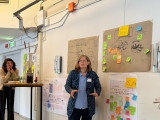
Circular initiatives often struggle to progress beyond the pilot phase, including circular charging infrastructure. Numerous barriers hinder these circular initiatives:
• Lack of data on products and how circular/sustainable they are.
• Difficulty in implementing circularity across the entire production chain.
• Regulatory obstacles.
• Current higher costs associated with circular production, leading to more expensive products.
To overcome these barriers, adjustments to regulations are necessary to better align with circular initiatives, alongside the establishment of shared ownership within the production chain.
True Price Lab is launched

The True Price Lab is a project focusing on willingness to pay the true price for food and drink.
From 26 February to mid-June 2024, the restaurant and espresso bar in the Corry Tendeloo Building of the Amsterdam University of Applied Sciences will be dedicated to the True Price Lab. For four months, students and staff will be able to choose between paying the normal or true price for a number of products. This project is an initial exploration of consumers' willingness to pay the true price, which includes hidden environmental and social-impact costs.
True price versus consumer price
The true price can be defined as the price applicable after calculating and improving the true price of a product. The true price is based on the retail price plus the sum total of external social and environmental costs. Traditional pricing disregards these external costs, which are effectively paid for by society. For example, the retail price of a cup of coffee does not include the environmental damage of pest control or the underpayment of the farmers who grow the coffee.
The full extra amount that participants pay when they voluntarily opt for the true price will go to the non-profit organisation Solidaridad. Solidaridad wants to make the world a place where everything is made and bought in solidarity with people, the environment and future generations. Visitors to the restaurant and espresso bar can learn more about what their contributions will be used for by scanning a QR code.
Research project - Shifting circular: urban infrastructure and policy changes towards renewed territorial metabolisms
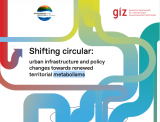
Find out this comparative analysis of critical policies and infrastructures essential for advancing the urban circular transition!
This piece of work draws upon the insights garnered from the experiences of four European cities, including Amsterdam. Reflecting on pivotal levers and obstacles pivotal in catalyzing socio-ecological transformations towards alternative urban metabolisms forms the crux of this exploration. This insightful report, commissioned by the Deutsche Gesellschaft für Internationale Zusammenarbeit (GIZ), the German agency for international cooperation, has been recently unveiled within the Circular Economy Solutions Dialogue (CESD) under the auspices of the Think20 (T20) working group focused on sustainable urbanization.
As a PhD researcher, I am now embarked on another research project on circular policies and strategies. One of my fieldwork is based in Amsterdam, spanning from January to April 2024. I am enthusiastic about establishing connections and potentially collaborating during my stay in the city!
How can parametric analysis optimise urban design of Schinkelkwartier - the best masterplan in the Netherlands in 2021

On Thursday, March 17 Grisha Zotov pitched some of the dilemmas his team encountered during the process of urban design. Among others, he touched upon densification and building height as aspects that influence intensity of human interaction.
Located in the former industrial zone, Schinkelkwartier is an example of inclusive and interdisciplinary redevelopment. Destined to be a diverse mix-use hub, Schinkelkwartier will develop in several phases during 25 years. At an early stage local stakeholders and neighbors of the area were involved.
On behalf of Architectural Prescription Grisha raised questions about opportunities and risks offered by water-related location and complexity due to the amount of interested parties.
Suggestions, ideas and feedback are always welcome.
Local or guest, reach out and share what you think!
Building a shared vision of the city - with LEGO!
Building the largest interactive LEGO model of the future city ever!
Imagine a model of the city; however, instead of a literal representation, this is a sculpture that holds ideas and dreams from citizens, policymakers, entrepreneurs and visitors about what the city might be like after we solve major transitional challenges (e.g. sustainability, energy, equality, smart).
What would it feel like to be in this city? What do people wish this future city to become?
the goal
A model of the city that contains the ideas that a diverse group of people have about how the city might emerge from major transitional change like climate adaptation, sustainability, equality, smart. Imagine the city from what might be and what opportunity change offers.
the form
A room-sized model built with LEGO in a public space and with interactivity (e.g. app / QR link / AR) to share the stories that this model contains.
the process
Lego is an powerful way to evoke and capture stories about how people think about something. Through a series of workshops, people from all parts of the city will be invited to share how they think about the future of the city and capture their stories in a collective model. An interactive installation opens up those stories to passers-by and other participants.
partners
finance, organisational, tech
call to action
Get in touch if you want to contribute to the realisation of the largest LEGO city vision model ever!
Van Afval naar Oogst

We gooien in Amsterdam nog steeds ons gft-afval bij het huishoudelijke afval. Zonde vinden wij! Van dit gft-afval kan namelijk goede compost gemaakt worden. Daarom zijn we in mei 2020 samen met Stichting Onschatbare Waarde van start gegaan met het project Van Afval naar Oogst.
De centrale locatie van het project is in de buurttuin van I Can Change The World With My Two Hands, een initiatief van Onschatbare Waarde, in Amsterdam West. Onze gezamenlijke ambitie was 100 Amsterdammers te betrekken bij afvalscheiding en hergebruik. Meer dan 100 mensen hebben zich aangemeld en leveren nu wekelijks hun gf-afval in bij de buurttuin waar waardevolle compost van wordt gemaakt.
De Gezonde Stad werkt aan een groene, circulaire en inclusieve stad, niet door er lang over te praten, maar door te doen, samen met een community van bewoners, bedrijven, overheden en andere organisaties. We planten bomen, leggen buurtparken en moestuinen aan, we organiseren events om lokaal voedsel op de kaart te zetten, we zijn trekker van het platform Van Amsterdamse Bodem en we sluiten kringlopen, zodat afval weer tot iets waardevols kan worden omgezet.
Volg ons op social media of check degezondestad.org om op de hoogte te blijven.
CINDERELA living lab

From urine to plant 'food'
CINDERELA is a demonstration plant that transforms urine into nutrient-rich fertilizer. The plant is located at Marineterrein Amsterdam Living Lab (MALL), and consists of a refurbished shipping container – containing a laboratory and two urine-diverting toilets – and an adjacent greenhouse which also serves as a meeting space.
Visitors of the Marineterrein who use the toilets can witness how their urine is stabilized and purified in a bioreactor, and then distilled and concentrated into organic plant 'food'. At the demonstration plant, the urine is separated by the diverting toilets after which it is treated and 100% converted to usable raw material streams: nutrient-rich fertilizer and 'clean' water.
These two resulting products: the fertilizer – free of bad odor, pathogens or micropollutants – and water, will be used in the greenhouse and vegetable garden adjacent container, showcasing how nutrient-recovery technologies can be implemented to turn waste into resources and close the nutrient loop/create circular food systems.
Toilets that 'save' urine from the sewage system
So what actually makes urine a valuable organic waste stream? Its Nitrogen and Phosphorus content makes it a good fertilizer and compost accelerator. However, as you can imagine, it needs to be treated first to remove its bad odor and contaminants. In our innovative CINDERELA project, all available nutrients are recovered from urine.
In order to achieve this, a new type of toilet is used – developed by EAWAG, EOOS and LAUFEN – which looks just like a normal toilet. The only difference is that these toilets have an internal curved section that catches liquid on and around the bowl. By collecting the urine before it ends up in the sewage system, these toilets allow this waste stream to be re-purposed.
Separating urine before it ends up in the sewage systems is an effective recovery approach, as urine makes up roughly ~1.5% of the volume of sewage yet contains ~55% of its Phosphorus content and 80% of the Nitrogen (the two main nutrients needed for a fertilizer).
CINDERELA’s urine to fertilizer process is largely based on the “VUNA” process developed by scientists at EAWAG. “Aurin” is the resulting fertilizer commercialized by EAWAG’s spinoff “VUNA”.
Why is it important to recover nutrients from our wastewater?
Nitrogen and Phosphorus are among the nutrients which can be recovered from urine. These two nutrients together with other macro- and micronutrients are essential for plant growth and thus the production of our food.
However, the current model for managing these nutrients in our food cycle is out of balance and unsustainable. Modern agriculture relies heavily on the use of mineral/synthetic fertilizers as a source of nutrients. This is problematic because both the production and usage of these nutrients cause problems:
(1) production of mineral/synthetic fertilizers is dependent on fossil and mineral reserves. Nitrogen fertilizers are derived from the energy-intensive conversion of atmospheric nitrogen into ammonia (known as the Haber-Boshprocess). Phosphorus is obtained from the mining of phosphate rock reserves, which are finite and limited to a few locations around the globe.
(2) the intensive use of fertilizers is increasing (roughly doubling) the input of available nitrogen and phosphorus into natural ecosystems which has severe ecological consequences. The over availability of fertilizers used on fields ends up in our water systems. This causes eutrophication: a dense growth of plant life that can disrupt existing eco-systems.
Circular use of Nitrogen (N) and Phosphorus (P) (e.g. recycling the nutrients in our wastewater back to food production) is essential to, on the one hand, reduce our dependency on fossil and mineral reserves, and on the other avoid the negative ecological impact of “waste” nutrients ending up in the environment.
Closing the loops
The process of transforming urine into fertilizer in itself sounds innovative, we can imagine. On its own, this concept of recovering nutrients from urine is not new as there are several projects in place in which this is done. There are however a few reasons why our CINDERELA project is particularly innovative:
- Firstly, let's start of with the way the urine is collected in this project. In many cases, projects (can) only make use of urinals. The toilets available in this project can be used by anyone, which enables us to collect greater amounts of this waste stream, without the need to change user's habits.
- Secondly, many of the existing projects that focus on recovering nutrients from urine are limited to retrieving struvite (which contains phosphorus, and limited amounts of nitrogen). In this project, all available nutrients are retrieved. Adding to this, the residual water, after struvite recovery, is still water waste. At the CINDERELA demonstration plant, the full urine stream is treaded and reused. Plants and greens will be grown with the recovered nutrients as well as the water;
- Thirdly, at this living lab plastic is collected separately – according to type and quality – to be recycled using AM techniques. After washing and grinding this plastic, it is used in 3D printing to make components to build a customizable freestanding planted wall – a perfect spot for the plants and greens to grow.
- Last but not least, 'closing the loop' with regard to all the above: the CINDERELA living lab contributes to creating a local circular system as the entire loop of organic and inorganic waste streams is closed; from urine to fertilizer and water, from plastic to a plant-wall.
Larger project scope
This experiment is part of a larger European project that focuses on recycling resources and waste material in the construction center. The overall objective of CINDERELA is to unlock the potential for a resource-efficient urban and peri-urban construction sector by developing a new Circular Economy Business Model (CEBM) for use of secondary raw materials (SRM) produced from different waste streams – such as wastewater – within urban and peri-urban area. Read more about the project here.
The 100 Intelligent Cities Challenge

The 100 Intelligent Cities Challenge (ICC) is a European Commission initiative that supports 136 cities in using cutting-edge technologies to lead the intelligent, green and socially responsible recovery. The ICC cities and their local ecosystems will be engines for the recovery of their local economy, create new jobs, and strengthen citizen participation and wellbeing.
The ICC is part of a wider EU support system that recognises the importance of delivering on the promises made by the European Green Deal, the digital strategy, and other EU policies. It looks to move towards a more digital, service-oriented and low-carbon economy, supported by a knowledge-based society, that enables circular economy systems through ‘local value loops’, evidence-based reskilling, and sustainable investments.
Participating cities receive one-to-one strategic advice from international experts on fine thematic strands: green economy and local green deals, improving the citizen participation and the digitalisation of public administration, green and digital transition in tourism, resilience of local supply chains, up- and reskilling of the workforce. ICC Cities are also supported by transversal services on access to data, access to finance and through a marketplace full of innovative solutions.
The Amsterdam Region, represented by Amsterdam Economic Board and Amsterdam Smart City (ASC) is one of the ICC mentor regions, alongside European mentor cities Aarhus, Antwerp, Barcelona, Espoo, Hamburg, Nice, Porto, Rijeka and international mentors Medellin, Singapore and Toronto. By participating in the ICC, the Amsterdam Region will share its experience and learn from other best practices related to multi-stakeholder collaboration, innovation ecosystems, circular economy and citizen participation.
ICC Updates:
• Launch of 100 Intelligent Cities Challenge
• ICC Challenge Mayors’ Summit
• Launch of ICC Renovation Action Group
• Public Kick-off 2nd ICC City Lab
• ICC - 3rd City Lab
• 200 Intelligent & Climate Neutral Cities Jam
• ICC - 4th City Lab
• Invitation to co-create European transition pathways for more resilient, greener and digital industrial ecosystems
• ICC - 5th City Lab
• Developing circular and sharing economy practices in cities
• The 100 Intelligent Cities Challenge: Looking Back & Looking Forward (End of Phase 1)
Space for Food: Space technology for sustainable food systems on Earth
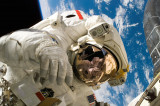
A big part of innovation in space technology revolves around finding smart, efficient and circular ways to establish a life support system for the astronauts going on the trip. Since it’s simply impossible to bring an end-less amount of resources on board, how do you make sure the astronauts can eat, drink and breath?
What if we view “cities as spaceships”; in terms of urban environments being ‘closed-loop systems’? This gives way to the idea that the same space technology developed by ESA could be applied to increase circularity in a city like Amsterdam.
Towards circular resource streams
Municipal wastewater is a great resource for nutrients and water reuse. The Space for Food project aims to use space technology in recovering nutrients and cleaning wastewater that can be used in food production using vertical farming. Closing the loops from waste to resource will help improving the impact in the environment, while creating resilience for the cities.
For this reason, the project will test a proof of concept using a raceway reactor for purple bacteria cultivation on brewery and municipal yellow wastewater at Marineterrein Amsterdam Living Lab. The biomass will be used as slow release fertilizer and bio-stimulant for cultivation of vegetables.
52 weken duurzaam, we gaan het gewoon doen.
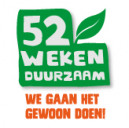
52wekenduurzaam nodigt je uit om je eigen leven stap voor stap duurzamer te maken. Een jaar lang iedere week een kleine verrassende en duurzame stap. Om te zien of het bij je past. Word je er gelukkig van, dan hou je het vol. Zo niet, dan skip je het. Wij onderzoeken wat er wel kan. Uitdagend, leuk, leerzaam en gratis. Loop je een stukje met ons mee?
Wij denken dat we met elkaar op een gemakkelijke manier veel duurzamer kunnen worden. Door elkaar te inspireren en uit te dagen. Door leuke en verrassende dingen te onderzoeken. Om zo je eigen versie van een duurzame leefstijl te ontwikkelen. We streven naar 5000 deelnemers in 2021. Hoe meer mensen meedoen, hoe beter. Voor onze Totale Impact Score, maar ook voor jezelf, want samen is veel leuker dan alleen. Dus geweldig als je nu al je gezin, je buren, vrienden en collega’s inspireert om ook mee te doen.
Communication Alliance for a Circular Region (CACR)

De taskforce Communication Alliance for a Circular Region (CACR) wil de circulaire economie in de Metropoolregio Amsterdam versnellen met praktische verhalen voor en over ondernemers en bedrijven. We nodigen iedereen uit mee te doen met de discussie op amsterdamsmartcity.com. De CACR bestaat uit: Hogeschool van Amsterdam | Gemeente Amsterdam | Amsterdam Economic Board | Amsterdam Smart City | Metabolic en AMS Institute.
Artikelen 'Circulaire economie en data'
• Volop kansen in de nieuwe circulaire werkelijkheid / Data zijn de zuurstof van de circulaire economie: deel 1
• Slim datagebruik in de circulaire economie: de drie belangrijkste redenen / Data zijn de zuurstof van de circulaire economie: deel 2
• 100.000 bedrijven restafvalvrij in 2025
• Slim datagebruik in de circulaire economie: dit is wat bedrijven zelf kunnen doen / Data zijn de zuurstof van de circulaire economie: deel 3
Artikelen circular strategies
Maak je bedrijf toekomstbestendig met deze circulaire strategieën
--------------------------------------------------------------------------------
The taskforce Communication Alliance for a Circular Region (CACR) is working to accelerate the circular economy in the Amsterdam Metropolitan Area, sharing practical stories for and about entrepreneurs and businesses. The CACR is an initiative by Amsterdam University of Applied Sciences | City of Amsterdam | Amsterdam Economic Board | Amsterdam Smart City | Metabolic | AMS Institute.
Articles 'Circular economy and data'
• A wealth of opportunities in the new circular reality / Data is the oxygen that the circular economy thrives on: part 1
• Smart data usage in the circular economy: 3 key reasons / Data is the oxygen that the circular economy thrives on: part 2
• 100,000 companies residual waste-free by 2025
• Smart data use in the circular economy: this is what companies can do themselves / Data is the oxygen that the circular economy thrives on: part 3
Articles: Future-proof your business using circular strategies
Wicked Problems
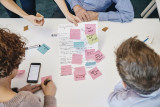
Te wicked? Niet voor ons.
Wij werken allemaal aan urgente, complexe, maatschappelijke uitdagingen. Issues die schier onoplosbaar lijken, van dilemma’s en paradoxen omgeven, nog niet duidelijk hoe het moet. Wel is duidelijk dát het moet, dat we elkaar nodig
hebben en dat we er NU aan moeten beginnen. Om met de woorden van Jan Rotmans te spreken; we leven niet in een tijdperk van verandering maar in een verandering van tijdperk. En hier hoort een nieuwe gereedschapskist bij.
En of je nou aan energietransitie werkt, andere mobiliteitssystemen, creëren van waterstofhubs, peer to peer autodeelsystemen, het maakt niet uit, we zien dat al deze opgaven op enig moment tegen gelijksoortige barrières aanlopen. Op samenwerking, financiering, privacy, onvoldoende aansluiting op de maatschappij, om maar een paar voorbeelden te noemen.
Unieke samenwerking
Als Amsterdam Smart City netwerk willen en kunnen we deze opgaven niet laten liggen. Door het bundelen van onze kennis en expertise kunnen we als netwerk iets unieks bieden en de wil en durf tonen om deze barrières te doorbreken. De betrokken partners die dit uitdenken en begeleiden zijn RHDHV, Kennisland, Drift, NEMO, Arcadis, Alliander, HvA en Metabolic. Zij bundelen hun expertise en ervaring om de echte vragen boven tafel te krijgen, tot nieuwe manieren van samenwerken te komen en barrières te doorbreken. We richten ons met name op de start van de samenwerking. Gezamenlijk ontwikkelen we een ‘wicked problem aanpak’. Op een nieuwe manier, lerend door te doen, exploratief.
Waar moet je aan denken?
Wat is eigenlijk het echte probleem? Wiens probleem is dit? Hoe kijken anderen er tegenaan? Welke andere partijen lijken nodig? Hoe vind je ze? Hoe ga je om met eigenaarschap en botsende frames? Hoe zorg je dat je al in
een vroeg stadium de maatschappij (bewoners, ondernemers, werknemers, etc) betrekt en hun ervaringen in het project trekt? Het wicked problem team zet nieuwe methoden in voor het beantwoorden van deze vragen. En het creëren van de benodigde commitment om het vraagstuk aan te pakken. Niets staat van te voren vast, want we passen ons aan aan wat we tegenkomen. Met elkaar ontwikkelen we een nieuwe aanpak om de barrières te doorbreken.
Isolde de Ridder Sieraden
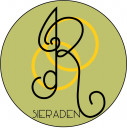
At Isolde de Ridder Sieraden, founded by Isolde de Ridder – Le Creurer in 2017, creating high-end jewellery with the greatest of care for both people and planet, is our mission. We strive to make the world more beautiful with our unique jewellery. Our unique pieces are crafted by hand in the Netherlands. Jewellery that give discarded metals and other materials a second life and that contribute to a better world for generations to come.
Upcyclecentrum Almere

In the Upcyclecentrum we make the circular economy and the upcycle process visible and tangible. We don’t do this alone. Our residents provide us with raw materials by properly separating their waste, the entrepreneurs (startups) upcycle these raw materials into new products and inspiring workshops are organized in our circular designed experience center. Waste = raw material in the circular economy; this is the central theme of all our activities.
Follow us on instagram on www.instagram.com/upcyclecentrum
#upcyclecentrum
3-CYCLE
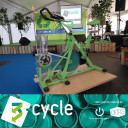
We are 3-CYCLE, a new upcycling project by Erik Fakkeldij (The Botfactory) and Joost Bosker (Oerz). We joint forces in 2019 to create new products from used pieces of plastics and metal. And... to make this a true dutch innovation, we use a setup with a bike to do the first steps of the upcycling process!
But that's not all... we do this by giving workshops and presentations to kids and the public to create more awareness. Our aim is to show that waste is not only bad for the environment, but it also means missed opportunities for reusing the waste and upcycling it into new products.
We believe this type of education is key for engaging the public, while making a
difference at the same time.
Unravelau

Unravelau is a high-end fashion brand established in 2017 by the designer Laura Meijering who believes that you don’t have to sacrifice style in order to make conscious choices. While each collection is unique, they are all designed with care for the planet. Our garments are handcrafted in The Netherlands and made of natural and upcycled materials only. At Unravelau, we believe that every little step counts - together with you, we unravel the fashion industry. One garment at a time.
Solar Decathlon Europe

The Call for Cities for the Solar Decathlon Europe 2023 has been published. This would be a huge opportunity for Amsterdam to host this event to raise energy literacy.
Seenons
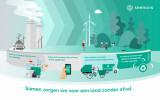
Samen maken wij 100.000 bedrijven restafval-vrij in 2025!
Seenons maakt het omschakelen naar een duurzame bedrijfsvoering gemakkelijk.
Seenons bundelt de krachten van traditionele afvaldienstverleners en duurzame logistieke partijen in een intelligent platform. Jij geeft aan welke specifieke afvalstromen er vrij komen bij jou in het bedrijf. Wij kijken welke partij bij jou in de buurt is en halen het afval op de meest duurzame manier op. Dit gebeurt allemaal contract vrij en is optimaal flexibel opgesteld. Geen vaste dagen met betrekking tot het ophalen. Simpelweg: bak vol? Geef het door, wij regelen de rest!
Op de hoogte blijven van ontwikkelingen of meer informatie?
Stuur een mailtje naar <hallo@seenons.com>
EC-Link Platform

You would like to connect with Urban Environmental Sustainability practitioners and researchers in China and exchange your approaches to green transport, clean energy, compact urban development, water and solid waste management, green buildings and municipal finance? Then sign up to the EC-Link platform! The platform links Eco Cities across Europe and China, offering inspiring examples from both sides of Eurasia and enabling direct contacts to the innovators. With the help of an integrated translation tool, posts can be translated into Chinese and English with just one click. Use of the platform is free of charge: http://eclink.org/bbs/#/?lang=en
A description of how the platform works can be downloaded here: http://eclink.org/ec_platform/upload/document/EC-Link_Users'%20Guide-EN.pdf
Stay up to date
Get notified about new updates, opportunities or events that match your interests.

